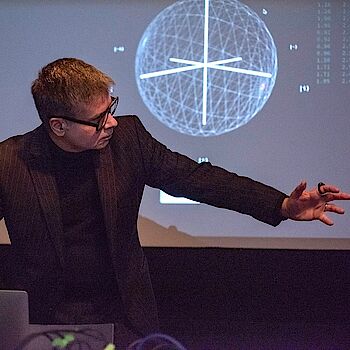As quantum computing technology looms on the horizon, on January 30th, 2024, the Einstein Center Digital Future (ECDF) presents an unprecedented performance of music created with quantum computers at the University of Plymouth’s Interdisciplinary Centre for Computer Music Research (ICCMR) in collaboration with the Wearable Computing Group of Berlin University of the Arts and ECDF. Unfortunately, the event is already fully booked and registration is no longer possible.
Pogramme:
17:00 - Pre-concert talks and demonstrations
During the Pre-Concert talks, Eduardo Reck Miranda (ICCMR, University of Plymouth) will introduce the field of (gate-based) quantum computing and how musicians have been using it to make music; ECDF-Professor Berit Greinke (University of the Arts and Einstein Center Digital Future) will introduce research on textile wearables and music performance and ECDF-Professor Janik Wolters will talk about the interplay of Quantum Light and Quantum Music. During the talks, the scientists will also do a demonstration of a brain-computer interfacing system.
18:00 - Concert followed by Q&A and get together
Zeno 2.0– for alto flute, bass clarinet and electronics
By Eduardo Reck Miranda
Performers:
Carla Rees, alto flute
Fie Schouten, bass clarinet
Eduardo Reck Miranda, electronics
Paulo Itaborai, electronics
Swirling Qubits – for Q1Synth and gestural controllers
By Eduardo Reck Miranda
Performers:
Federico Visi, Q1Synth gestural controllers
Maria Aguado, Q1Synth software
Pre-Concert Talks and Demonstrations:
The developments of new types of computers for music and new types of interfaces to control them walk hand in hand. In this talk, the speakers introduce their research into harnessing quantum computers to make music and the development of new interfaces for musical interaction, respectively. After a short introduction to quantum computing and wearable computing, the authors will show examples and live demonstrations of ongoing projects to interface the human brain with quantum computers and develop intelligent garments for controlling music with gestures. During the talk, artist and developer Colin Harrington will attempt to control quantum sound synthesisers with a bespoke brain-computer music interface. A Q&A session on the impact of quantum and wearable computing technologies on music will take place at the end.
The Compositions
Zeno 2.0– for alto flute, bass clarinet and electronics live and pre-recorded
By Eduardo Reck Miranda
Duration: c.15 mins
Performers:
Carla Rees, alto flute
Fie Schouten, bass clarinet
Eduardo Reck Miranda, electronics
Paulo Itaborai, electronics
Zeno 2.0 was composed using generative AI algorithms running on quantum computers. Its performance involves live interaction through the Internet with an IQM quantum computer based in Finland.
A quantum computer deals with information encoded as quantum bits - or qubits. They are subject to the laws of quantum mechanics. The composer leveraged quantum mechanical phenomena, such as superposition, entanglement, and interference, to create musical materials for Zeno 2.0 in ways that would be impractical using a standard digital computer.
The QuPoly program, developed with a team at the University of Plymouth’s Interdisciplinary Centre for Computer Music Research (ICCMR), listens to the flute and the clarinet and uses quantum mechanics to produce musical responses during the performance.
The piece is a tribute to Zeno of Elea, a pre-Socratic Greek philosopher and mathematician considered the inventor of dialectics.
Swirling Qubits – for Q1Synth and gestural controllers
By Eduardo Reck Miranda
Duration: c. 12 mins
Performers:
Federico Visi, Q1Synth gestural controllers
Maria Aguado, Q1Synth software
The Q1Synth is an unprecedented musical instrument that renders sounds from quantum states. It is played by swirling a representation of a qubit shown on the screen and measuring the respective quantum states.
In Swirling Qubits, the performer uses gestural controllers to create quantum states with four connected Q1Synths. The music is produced by putting their qubits in superposition and entanglement. The instrument is connected via the Internet to an IQM quantum computer to calculate the respective quantum states.
The Q1Synth instrument was developed by the composer and his team at ICCMR. Berit Greinke and Federico Visi developed the gestural controller at Berlin University of the Arts and Einstein Centre Digital Future.
About Quantum Tunes: Mind and Wiggle
In the 20th century, avant-garde composers changed the face of music through electronic technologies and experiments with rule-based models and open forms.
As early as the 1930s, Edgar Varèse varied the speed of turntables to create distortions and collage effects. However, it was not until the 1950s that significant new approaches to musical composition began to emerge. In 1951, John Cage used an Oriental oracle to create Music of Changes for piano: he consulted the I Ching to make compositional decisions. Around the same time, Pierre Boulez composed Structures for two pianos. Pre-determined rules decided every aspect of this piece, which Boulez followed strictly. Soon after, Karlheinz Stockhausen created Klavierstück XI also for piano. It consisted of fragments, which the pianist could perform in any order they wished.
With the advent of digital computers, composing like Varèse, Cage, Boulez or Stockhausen became mainstream. Nowadays, composers are versed in using computers to manipulate recordings, follow the rules, and improvise. But computing technology is ever-evolving. And so is music.
The music of the 21st century is changing through Artificial Intelligence, new types of computers and new types of interfaces. Most notably, quantum computers, brain-computer interfaces, and smart fabrics.
A quantum computer deals with information encoded as quantum bits - or qubits. The qubit is to a quantum computer what a bit is to a digital one: it is a basic unit of information. In hardware, qubits live in the subatomic world. They are subject to the laws of quantum mechanics. Thus, qubits process information in fundamentally different and potentially more powerful ways than digital bits. Quantum computing is bound to open new and exciting opportunities for creative practices.

